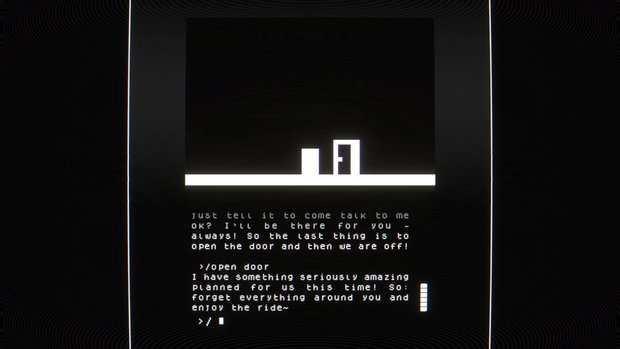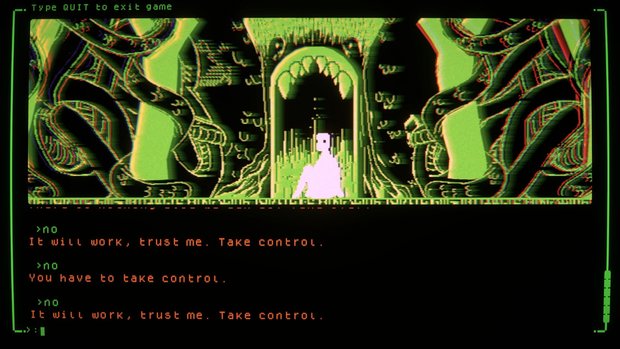[I] Doesn’t Exist review
![[I] Doesn’t Exist review [I] Doesn’t Exist review](/images/posts/607/1049-i-doesnt-exist-review-teaser.png?f=articlecenter)
- 0 Comments
Experimental illustrated text adventure defies classification but is often weirdly wonderful
>/ review
[review] doesn’t exist
>/ start
You are reading about a unique illustrated text adventure by LUAL Games, a two-woman indie studio. If, like many, you have a visceral allergic reaction to text adventures, keep reading anyway. I promise you will not be harmed in any way. You may even consider braving this visually arresting and brain-breaking world that throws a rather large wrench into the genre. While the current version is still a bit rough around the edges, and its surreal nature is perhaps a bit inaccessible, [I] doesn’t exist is a worthy escapade for the few hours it will take you to play.
>/ settings
Upon startup, you first notice the monochrome green screen with a distinct cathode ray tube effect and a blinking command prompt. If you are over the age of forty, you will likely be feeling nostalgia. If you are young and that blissful feeling does not wash over you, rest assured the format leaves the early 80s behind as you progress. You can also disable the CRT effect, along with keyboard sounds, if you are feeling positively modern.

>/ look around
After the first section with graphics straight out of a game written in BASIC, gorgeous early 90s-style pixel art graphics take up the upper half of the screen; every object is clearly drawn and can be interacted with. The character you control, a scrawny black humanoid cipher, will stand—heaving its chest—awaiting your instructions. And all commands you give it come with a simple but effective animation. The background music and sound effects are unobtrusive and would feel right at home coming from an early Sound Blaster card.
>/ use
If you have previously played text adventures and cursed their nature after guessing the wrong verb ad nauseam, you are in luck as this game understands conversational English. For example, you are encouraged to walk to a door as the game opens. Below are commands of mine that were accepted:
– Walk to the door
– Go to door
– Go east
– Move right
– Mosey on over to the door(!)
The game doesn’t understand everything you try (strangely including one-word commands like “look,” a text adventure staple), but as there are no complex puzzles to solve, it is generally not an issue. Frustratingly, however, in some cases you’re required to be needlessly specific. At one point you must cut a chain, but writing CUT CHAIN is not understood unless you mention what item you want to cut it with. However, instead of the game replying “With what?” it thinks you want to cut the chain with your bare hands. Thankfully, the narrator will provide situational hints if asked.

The parser is not the only instrument at your disposal. You can scroll the mouse wheel up to view the current transcript of your previous commands and responses. There is also one avant-garde section that briefly requires the mouse to drag-and-drop, and yet another that requires the keyboard to move around in a three-dimensional environment.
>/ examine story
You are still reading. Great! So what is this game about, you wonder. At first it’s unclear, as you simply guide the cipher through a series of very basic adventure puzzles in an attempt to go through a door. A door that is nestled in a wooded area replete with a jukebox, public shower, and a vending machine—the types of incongruent items one was likely to find in early text adventures. If you want the rest to be a surprise (as it was for me), then skip ahead. All you need to know is that once you attempt to go through the door, the game turns the entire genre on its head, spins it around, and kicks it a few times for good measure.
Regardless of what you do, the cipher refuses to go through the door. Or accept any of your commands, for that matter. Meanwhile, the narrator (an on-screen mushroom that helped guide you through the first section) tries to fix things, begging you to distract the cipher in the meantime via conversation, finding ways to make it feel seen and understood, and not just a pawn to be ordered around.
The second half of the game becomes an exercise in fighting with the program itself, being caught in the middle between the exasperated cipher and the annoyed narrator. At times you appear able to pick sides in this fight, and at times you are simply along for the ride. There is little in the way of puzzles, though your input is requested frequently with little certainty that it matters. The world changes multiple times at the behest of the narrator, including one bizarre but mesmerizing three-dimensional section that includes a maze that guides you with existential questions written on the floor (and their answers veering off in separate directions), as well as an interrogation at the hands of the mushroom narrator about your understanding of this world and your intentions moving forward. At one point you’ll be left wondering if the game itself is even working properly. Nevertheless, every scene compels you to keep moving forward to unravel the mystery of who (if anyone) is really in charge of their fate.
>/quit
And then just when it seems like you’re getting somewhere, the game ends with you wondering what on god’s green screen just happened. I played through the game three times, finding two endings, but I honestly have no idea what I did to trigger the second one. And as I barely felt closer to understanding the big picture, I did not feel compelled to continue trying, especially since you must start from the beginning each time. On a couple of occasions the game froze on me, but thankfully upon restart I came back to where I was. On one playthrough, however, the game didn’t accept a necessary command to continue for no apparent reason, requiring me to start over.
Final Verdict
[I] doesn’t exist is fantastically weird and compelling, and it’s easy enough that exploring its entirety is relatively painless, with the first playthrough taking anywhere from one to two hours depending on how fast you solve the standard adventure game puzzles in the first half. I thoroughly enjoyed myself every step of the way, though the endgame is so brief and so vague that I wound up feeling disappointingly empty about the experience as a whole. I would still recommend it to fans of both text adventures and experimental gaming, but don’t expect its existential message to sit with you for long afterwards. That said, if the creativity present here is what we can expect to see going forward from LUAL Games, then color me excited.
Hot take
While it doesn’t quite reach the allegorical heights it aspires to, if you like text adventures or simply enjoy games that subvert the role of the player, then [I] doesn’t exist should keep you solidly entertained for a few hours.
Pros
- Unique presentation that both honors and subverts the standard text adventure
- Fluid parser understands a good deal of conversational English
- Engaging graphics that frequently change interface and perspective
Cons
- High-concept story feels vague and incomplete
- Subsequent replays to reach alternate endings with unknown triggers require full restart
- Potential for game-crashing bugs
Beau played [I] doesn’t exist on PC using a review code provided by the game's publisher.










0 Comments
Want to join the discussion? Leave a comment as guest, sign in or register in our forums.
Leave a comment